Improving stroke outcome: the benefits of increasing availability of technology
Richard F. Heller, 1 Peter Langhorne, 2 & Erica James 3
INTRODUCTION: A decision analysis was performed to explore the potential benefits of interventions to improve the outcome of patients admitted to hospital with a stroke, in the context of the technology available in different parts of the world.
METHODS: The outcome of death or dependency was used with a six-month end-point.
RESULTS: Four settings were identified that would depend on the resources available. The proportion of stroke patients who were dead or dependent at six months was 61.5% with no intervention at all. Setting 4, with the only intervention being the delayed introduction of aspirin, produced a 0.5% absolute improvement in outcome (death or dependency), and the addition of an organized stroke unit (Setting 3) produced the largest incremental improvement, of 2.7%. Extra interventions associated with non-urgent computed tomography and thus the ability to avoid anticoagulation or aspirin for those with a haemorrhagic stroke (Setting 2), and immediate computed tomography scanning to allow the use of thrombolytics in non-haemorrhagic stroke (Setting 1), produced only small incremental benefits of 0.4% in each case.
DISCUSSION: To reduce the burden of illness due to stroke, efforts at primary prevention are essential and likely to have a greater impact than even the best interventions after the event. In the absence of good primary prevention, whatever is possible must be done to reduce the sequelae of stroke. This analysis provides a rational basis for beginning the development of clinical guidelines applicable to the economic setting of the patient.
Keywords: cerebrovascular accident, mortality; cerebrovascular accident, therapy; treatment outcome; decision support techniques; tomography scanners; aspirin, therapeutic use.
Introduction
Stroke presents a major public health challenge, with a high case fatality and a large proportion of survivors dependent on nursing and other care. Over the past few years clinical practice has changed considerably especially in the investigation of stroke and there are several promising interventions being developed, including new drug treatments (1). Clinical guidelines (e.g., from the American Heart Association (2) and the Scottish Intercollegiate Guidelines Network (3)) are now being developed to guide best practice in the context of these new developments in clinical care. Consensus guidelines are recognized to vary and to need an international perspective (4). Because many of the investigations and treatments featured are not widely available in the developing world, we aimed to explore the potential benefits on stroke outcome of management strategies associated with reduced availability of resources.
Materials and methods
A decision analysis was performed with the data package program (5). We chose the outcome of death or dependency (i.e. continued physical dependence) as this is used in many of the trials from which data are available. The converse of this outcome is functional independence. We have taken a six-month end-point.
We defined four settings according to the resources available and the subsequent interventions that could be provided. The interventions selected are supported by more than one randomized trial (Box 1).
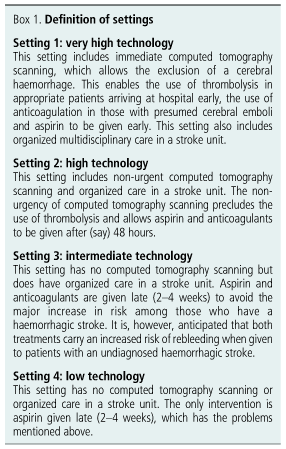
We estimated the proportions of the major types of stroke and the expected outcomes from the literature (612) to allow us to perform a decision analysis (Box 2). The benefits and risks of each intervention have also been determined from a review of the literature (see Table 1).
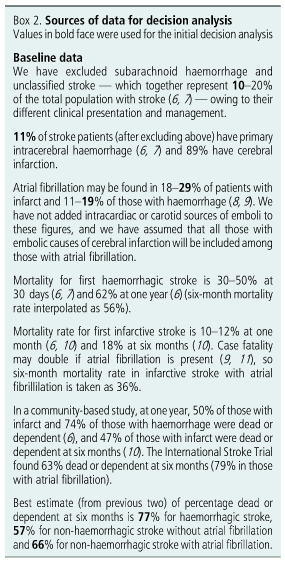
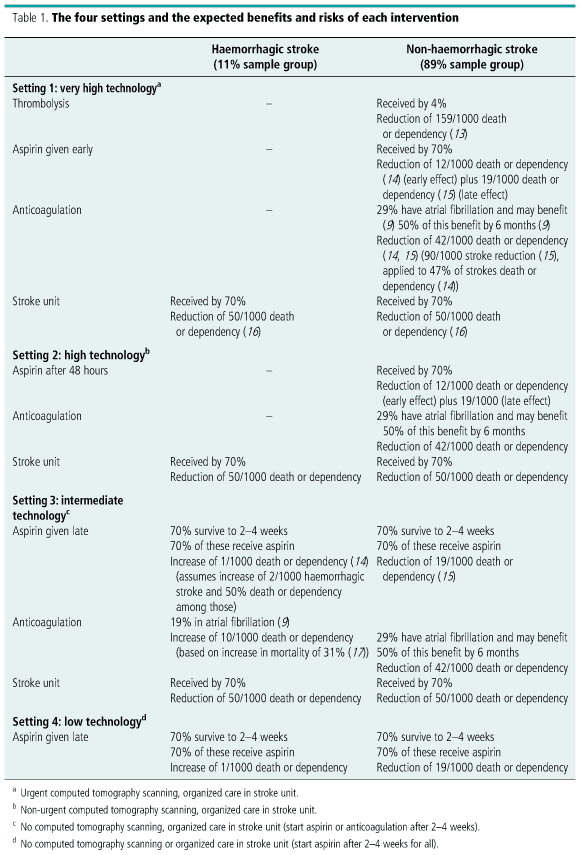
Frequency of stroke types and their sequelae
Much of the data comes from the Oxfordshire Community Stroke Project (10, 11) as it is a large, well performed study that takes as its entry point all patients in a defined community who presented with a first stroke (even though not all patients were admitted to hospital). More recent data on stroke outcome comes from the International Stroke Trial (12). Other data have come from various sources in the literature. We have chosen the prevalence of atrial fibrillation as an estimate of the proportion of patients with a clinical source of emboli, although this underestimates those with potential sources of emboli from intracardiac or other sources. Box 2 shows the data and their references.
Complications and benefits of treatment
Data on the complications and benefits of treatment come from a variety of systematic review sources (see Table 1). The end-points reported in the papers varied: one month, three months, six months and one year. We have chosen six months as our main outcome measure, where necessary extrapolating between one month or three months and one year if the data were not given for six months.
Decision analysis
A decision tree was created, which listed the different options and their consequences. The probabilities of the final outcomes were obtained by multiplying the probability of the intermediate outcomes by the prevalence of each type of stroke and the consequences of medical decisions along the decision tree. The decision tree was used to compare the four different settings.
Sensitivity analysis
We have explored the impact on our results of variation in these estimates via a sensitivity analysis. This involves repeating the analyses with different frequency and effect estimates as part of a systematic variation of the estimates chosen in the decision analysis. It is possible that the outcome of stroke is better than that reported in our literature sources, and we have examined the impact of a 10% reduction in the proportion of patients dead or dependent. The proportion of strokes due to haemorrhage is said to be greater in parts of the developing world (18), and we therefore varied this factor in our sensitivity analysis from 11% to 25%. The proportions of patients with atrial fibrillation among both haemorrhagic and non-haemorrhagic stroke types may influence our findings, and we have varied these, as well as the proportions of patients who might be treated in an organized stroke unit. We have also varied the proposed benefit of aspirin by doubling the published benefits (to reflect additional benefits that could come from newer antiplatelet agents such as ticlopidine or clopidogrel, although the size of any additional benefit is unlikely to be more than a 10% advantage over aspirin (19, 20)), and we have reduced the harm from aspirin and anticoagulation by halving our estimates of the adverse effects. The latter analysis reflected the clinical scoring schemes, which are claimed to be able to distinguish with reasonable sensitivity and specificity between haemorrhagic and infarctive strokes (21); although these are not deemed sufficiently accurate to be recommended in most guidelines. We therefore repeated the analysis for the groups in Settings 3 and 4 and assumed that they had only half the increase in death or dependency due to anticoagulation or aspirin of those with cerebral haemorrhage (but assumed that there was still a delay in starting these drugs). Finally, we increased the proportion of non-haemorrhagic stroke patients who would receive thrombolysis from 4% to 20%, to reflect changes in speed of arriving in hospital should thrombolysis be confirmed as a valuable intervention.
Results
Table 2 shows the results of the decision analysis for all strokes, haemorrhagic strokes and non-haemorrhagic strokes. The percentage of the population dead or dependent is reduced by a small amount whatever intervention is used. For Setting 4, where the only intervention is aspirin given late, there is a 0.5% absolute improvement from the baseline of 61.5% of patients dead or dependent to 61.0% when aspirin is given. When organized care in a stroke unit is added in Setting 3, there is an extra 2.7% improvement to 58.3% of patients dead or dependent. Settings 2 and 1 showed an additional 0.4% improvement to 57.9% and 57.5% respectively. When the different stroke types are examined, the outcome is worse in each category for haemorrhagic stroke, as would be expected, and the benefits from each intervention are smaller in haemorrhagic stroke, the only sizeable benefit coming from the addition of Setting 3, with organized care in a stroke unit.
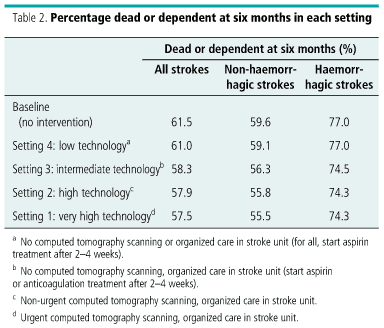
The sensitivity analyses made little difference to the ranking of the different settings, none of which were changed. The absolute percentages of patients who were dead or dependent varied with the different estimates put into the sensitivity analysis (Table 3).
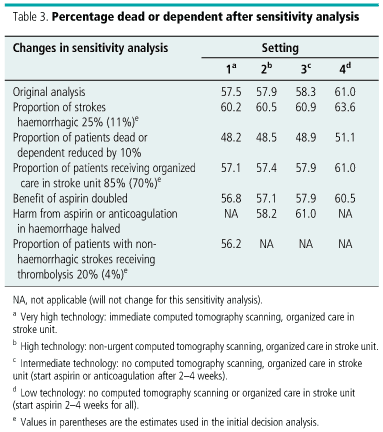
Discussion
We did not set out to challenge the notion that patients who receive the most accurate diagnostic services or effective treatment options are most likely to achieve a favourable outcome. We set out to address the problem of how to apply the best evidence from clinical trials (usually performed in developed countries) to help provide the best possible care for stroke patients in developing countries or other health care settings with low technology. Identifying the decision process and exploring the consequences of alternate decisions on important outcomes is likely to help develop such a rational approach (22).
Limitations
The results of our analysis depend on the estimates of frequency of each stroke category and of the effects of interventions on both intermediate and final outcomes. Although most of the data needed for this analysis were available from the literature there are several limitations. The main prevalence estimates come from the Oxfordshire Community Stroke Study, which reported first strokes that had come to medical attention. Only about one half of the patients were admitted to hospital (23) and hence clinical management decisions in a hospital setting may have a different impact according to selection factors operating locally. It is likely that the milder cases will not have been admitted to hospital, so the outcomes reported by this community-based study may be better than those found in hospital series. For this reason, we have also taken data from the International Stroke Trial to estimate outcomes. We have chosen to examine outcomes at six months, a point where data are often available, although the benefits of one type of intervention may be differentially better than another over a longer follow-up period.
Simplification of the diagnostic process
We have used data to reflect clinical decision-making as much as possible but have simplified the diagnostic process in two ways. First, we have ignored any possible misclassifications between haemorrhage and infarct on computed tomograms (24). Second, we have not taken into account the possible clinical deterioration due to haemorrhagic transformation of a cerebral infarct (25) after treatment with aspirin, anticoagulation or thrombolysis. These simplifications may influence the outcomes we have presented, but mainly in the direction of underestimating the dangers of antithrombotic drugs for patients with presumed cerebral infarction.
Sensitivity analysis
Although we have done our best to assess the literature accurately, we have included a sensitivity analysis to allow for variation in different clinical settings and to allow for differences in the results of interventions if the estimates varied from those we have chosen. No major impact on our conclusions could be found from this analysis, and although the individual values changed with each analysis, the ranking of the different settings we have described did not change. The results of the study suggest little impact on outcomes with increasing technology offered by computed tomography scanning. This does not mean that individuals will not benefit from accurate identification of a haemorrhage by computed tomography scanning, only that for the group of stroke patients as a whole the effect is small. Should the benefits of early thrombolysis be confirmed by future trials, it is possible that patients may arrive earlier in hospital, and our sensitivity analysis has shown an extra 1.3% reduction in death or dependency should the proportion of patients with non-haemorrhagic stroke receiving thrombolysis increase from 4% to 20%.
Organized inpatient care
The value of organized inpatient (stroke unit) care has been debated frequently in the past. However, there is now considerable evidence indicating a benefit on both survival and functional status (16, 26). Although there was variation in the proportion of all stroke cases admitted to the randomized controlled trials included in the meta-analysis (26), many included all patients admitted to hospital. We have assumed that rehabilitation can be offered to (and may benefit) most stroke patients, including both haemorrhagic and non-haemorrhagic strokes. As only about 70% of patients are likely to survive long enough to receive organized care in a stroke unit, this is the value we have chosen for the analysis (with a sensitivity analysis of up to 85%). The package of general care and rehabilitation, as characterized by admission to a stroke unit, seems to greatly outweigh the benefits of the other interventions. The real difficulty is in identifying the important components and developing a transferable technology of care that can be widely applied. This could be subject to economic analysis or cost-benefit analyses of the different management options. It is already clear that aspirin is cheap, can be applied with obvious benefit to most stroke patients and is likely to provide the most benefit for the least cost as a treatment for stroke patients in developing countries.
The small size of the benefits obtained by treating stroke once it has occurred is clear from this analysis. To reduce the burden of illness due to stroke, efforts at primary prevention are essential and likely to have a greater impact than even the best interventions after the event. In the absence of good primary prevention, whatever is possible must be done to reduce the sequelae of stroke. This analysis provides a rational basis for beginning the development of clinical guidelines applicable to the economic setting of the patient. 
Résumé
Améliorer lissue des accidents vasculaires cérébraux : lintérêt dun accès accru à la technologie
Les accidents vasculaires cérébraux constituent un problème majeur de santé publique, avec un taux de létalité élevé et une proportion importante, parmi les survivants, de personnes dépendantes ayant besoin de soins infirmiers et autres. Ces dernières années, la pratique clinique sest considérablement modifiée, en particulier en matière dinvestigation des accidents vasculaires cérébraux, et plusieurs interventions prometteuses, faisant notamment appel à de nouveaux traitements pharmacologiques, sont à létude. Nombre des investigations et traitements mentionnés ici ne sont pas partout disponibles dans les pays en développement, et cest pourquoi nous avons cherché à explorer les bénéfices potentiels, sur lissue des accidents vasculaires cérébraux, de diverses stratégies de prise en charge dans un contexte de ressources limitées. Une analyse décisionnelle a été réalisée pour explorer le bénéfice potentiel dinterventions visant à améliorer lissue dun accident vasculaire cérébral chez les patients hospitalisés pour ce motif, compte tenu de la technologie disponible dans différentes régions du monde. Quatre situations ont été identifiées, en fonction du niveau de ressources. Après un accident vasculaire cérébral, la proportion de patients décédés ou dépendants à six mois était de 61,5 % en labsence de toute intervention. Dans la situation 4, avec pour seule intervention une introduction différée de laspirine, le bénéfice absolu au niveau de lissue (décès ou dépendance) était de 0,5 %; la présence dun service organisé de prise en charge des accidents vasculaires cérébraux (situation 3) produisait le plus fort bénéfice additionnel, soit 2,7 %. Des interventions supplémentaires consistant en une scanographie non pratiquée en urgence et permettant déviter ladministration dun anticoagulant ou daspirine à un patient victime dun accident vasculaire cérébral hémorragique (situation 2), et en une scanographie immédiate pour permettre lutilisation de thrombolytiques en cas daccident vasculaire cérébral non hémorragique (situation 1) ne produisaient quun bénéfice additionnel de 0,4 % chacune. Ces observations pourraient faire lobjet dune analyse économique ou dune analyse coût-avantages des différentes options de prise en charge. Il est déjà manifeste que laspirine est bon marché, quelle peut être administrée avec un bénéfice certain à la plupart des patients atteints daccident vasculaire cérébral et quelle offre probablement le meilleur bénéfice au coût le plus faible en tant que traitement des accidents vasculaires cérébraux dans les pays en développement. Il ressort clairement de cette analyse que les bénéfices apportés par le traitement de laccident vasculaire cérébral après sa survenue sont minces. Pour réduire la charge de morbidité due à cette affection, des efforts de prévention primaire sont indispensables et auront vraisemblablement un impact supérieur à celui des meilleures interventions mises en oeuvre après laccident. A défaut dune bonne prévention primaire, il faut faire tout ce qui est possible pour réduire les séquelles de laccident vasculaire cérébral. La présente analyse constitue une base rationnelle pour lélaboration de directives cliniques applicables au contexte économique dans lequel se trouve le patient.
Resumen
Mejora de la evolución de los accidentes cerebrovasculares: beneficios derivados de la mayor disponibilidad de tecnología.
Los accidentes cerebrovasculares (ACV) representan un importante desafío para la salud pública, debido a que se asocian a una alta tasa de letalidad y a que una muy elevada proporción de los supervivientes quedan en un estado que exige algún tipo de asistencia. Durante los últimos años la práctica clínica ha evolucionado considerablemente sobre todo en la investigación de los ACV y se están desarrollando varias intervenciones prometedoras, incluidos nuevos tratamientos farmacológicos. Muchos de esos tratamientos e investigaciones no pueden aplicarse fácilmente en el mundo en desarrollo, de ahí que nos propusiéramos examinar la mejora potencial del pronóstico de los ACV asociada a las estrategias terapéuticas que impone la escasez de recursos. Se llevó a cabo un análisis de decisiones para determinar las ventajas potenciales de las intervenciones encaminadas a mejorar el pronóstico de las víctimas de ACV ingresadas en hospitales, teniendo en cuenta la tecnología disponible en diferentes partes del mundo. Se identificaron cuatro situaciones en función de los recursos disponibles. La proporción de víctimas de ACV que habían muerto o vivían en una situación de dependencia a los seis meses era del 61,5% entre los casos en que no se había aplicado ninguna intervención. La situación 4, caracterizada por la administración tardía de aspirina como única intervención, determinó una mejora absoluta del 0,5% de los resultados (defunción o dependencia), y la adición de una unidad organizada contra los ACV (situación 3) determinó la mayor mejora porcentual: 2,7%. Otras intervenciones adicionales, como la práctica de una tomografía computarizada (TC) no urgente y la consiguiente posibilidad de evitar los anticoagulantes o la aspirina en quienes habían sufrido un ACV hemorrágico (situación 2) y la TC inmediata con miras a emplear trombolíticos en caso de ACV no hemorrágico (situación 1), se tradujeron sólo en una muy leve mejora, del 0,4% en cada caso. Con estos datos fue posible realizar análisis económicos y de costo-beneficio de las distintas opciones de tratamiento. Está ya demostrado que la aspirina, amén de barata, tiene efectos claramente beneficiosos en la mayoría de los pacientes que han sufrido un ACV y puede proporcionar el máximo beneficio por el mínimo costo como tratamiento de esos pacientes en los países en desarrollo. El análisis pone claramente de relieve la escasa magnitud de los beneficios conseguidos al tratar el ACV una vez que se ha producido. Las iniciativas de prevención primaria son fundamentales para reducir la carga de morbilidad por ACV y pueden tener un impacto mayor incluso que las intervenciones óptimas aplicadas después del episodio. A falta de una buena prevención primaria, debe hacerse todo lo posible para reducir las secuelas de los ACV. Este análisis esboza un marco racional para empezar a formular directrices clínicas que puedan aplicarse en las circunstancias económicas que rodean al paciente.
References
1. Fisher M, Bogousslavsky J. Further evolution toward effective therapy for acute ischemic stroke. Journal of the American Medical Association, 1998, 279: 12981303.
2. Adams HP Jr et al. Guidelines for the management of patients with acute ischaemic stroke: a statement for healthcare professionals from a special writing group of the Stroke Council, American Heart Association. Stroke, 1994, 25: 19011914.
3. Scottish Intercollegiate Guidelines Network. Management of patients with stroke. Edinburgh, SIGN, 1998.
4. Bogousslavsky J. Consensus in stroke management? British Medical Journal,1999, 318: 140141.
5. DATA 3.0 users manual. TreeAge Software, 1996. Williamstown, MA, USA.
6. Bamford J et al. A prospective study of acute cerebrovascular disease in the community: the Oxfordshire Community Stroke Project 198186. 2. Incidence, case fatality rates and overall outcome at one year of cerebral infarction, primary intracerebral and subarachnoid haemorrhage. Journal of Neurology, Neurosurgery and Psychiatry,1990, 53: 1622.
7. Anderson CS et al. Determining the incidence of different subtypes of stroke: results from the Perth Community Stroke Study, 19891990. Medical Journal of Australia, 1993, 158: 8589.
8. Britton M, Gustofsson C. Non-rheumatic atrial fibrillation as a risk factor for stroke. Stroke, 1985, 16: 182187.
9. Sandercock P et al. Atrial fibrillation and stroke: prevalence in different types of stroke and influence on early and long term prognosis (Oxfordshire Community Stroke Project). British Medical Journal, 1992, 305: 14601465.
10. Bamford J et al. Classification and natural history of clinically identifiable subtypes of cerebral infarction. Lancet, 1991, 337: 15211526.
11. Candelise L, Pinardi G, Morabito A. Mortality in acute stroke with atrial fibrillation. Stroke, 1991, 22: 169174.
12. International Stroke Trial Collaborative Group. The International Stroke Trial (IST): a randomised controlled trial of aspirin, subcutaneous heparin, both, or neither among 19 435 patients with acute ischaemic stroke. Lancet, 1997, 349: 1569 1581.
13. Wardlow JM, Warlow CP, Councell C. Systematic review of evidence on thrombolytic therapy for acute stroke. Lancet, 1997, 350: 607614.
14. CAST (Chinese Acute Stroke Trial) Collaborative Group. CAST: randomised placebo-controlled trial of early aspirin use in 20 000 patients with acute ischaemic stroke. Lancet, 1997, 349: 16411649.
15. EAFT (European Atrial Fibrillation Trial) Study Group. Secondary prevention in non-rheumatic atrial fibrillation after transient ischaemic attack or minor stroke. Lancet, 1993, 342: 12551262.
16. Stroke Uni Trialists Collaboration. How do stroke units improve patient outcomes? A collaborative systematic review of the randomised trials. Stroke, 1997, 28: 21392144.
17. Sandercock PAG et al. Antithrombolitic therapy in acute ischaemic stroke: an overview of the completed randomised controlled trials. Journal of Neurology Neurosurgery and Psychiatry, 1993, 56: 1725.
18. INCLEN Multicentre Stroke Collaboration. Variation in in-patient stroke management in ten centres in different countries. The INCLEN multicentre stroke collaboration. Journal of Neurological Sciences, 1999, 167: 1115.
19. Antiplatelet Trialists Collaboration. Collaborative overview of randomised trials of antiplatelet therapy 1: prevention of death, myocardial infarction, and stroke by prolonged antiplatelet therapy in various categories of patients. British Medical Journal, 1994, 308: 81106.
20. CAPRIE Steering Committee. A randomised, blinded, trial of clopidrogel versus aspirin in patients at risk of ischaemic events (CAPRIE). Lancet, 1996, 348: 13291339.
21. Weir CJ et al. Poor accuracy of stroke scoring systems for differential diagnosis of intracranial haemorrhage and infarction. Lancet, 1994, 344: 9991002.
22. Ebrahim S. Clinical epidemiology of stroke. Oxford, Oxford University Press, 1990.
23. Bamford J et al. Why are patients with acute stroke admitted to hospital? The experience of the Oxfordshire Community Stroke Project. British Medical Journal, 1987, 292: 13691372.
24. Foulkes MA et al. The Stroke Data Bank: design, methods and baseline characteristics. Stroke, 1988; 19: 547554.
25. Cerebral Embolism Study Group. Cardiogenic stroke, early anticoagulation and brain haemorrhage. Archives of Internal Medicine, 1987, 147: 636640.
26. Stroke Unit Trialists Collaboration. Collaborative systematic review of the randomised trials of organised inpatient (stroke unit) care after stroke. British Medical Journal, 1997, 314: 11511159.
1 Professor of Community Medicine and Clinical Epidemiology, Director, Centre for Clinical Epidemiology and Biostatistics, Faculty of Medicine and Health Sciences, The University of Newcastle, David Maddison Clinical Sciences Building, Royal Newcastle Hospital, Newcastle, NSW, Australia 2300. Correspondence should be addressed to this author at the following address: Professor of Public Health, Medical School, University of Manchester, M13 9PT, England (email: dick.heller@man.ac.uk).
2 Senior Lecturer, Academic Section of Geriatric Medicine, Royal Infirmary, Glasgow, Scotland.
3 Research Assistant, Centre for Clinical Epidemiology and Biostatistics, Faculty of Medicine and Health Sciences, The University of Newcastle, Australia.
Ref. No. 99-0218
